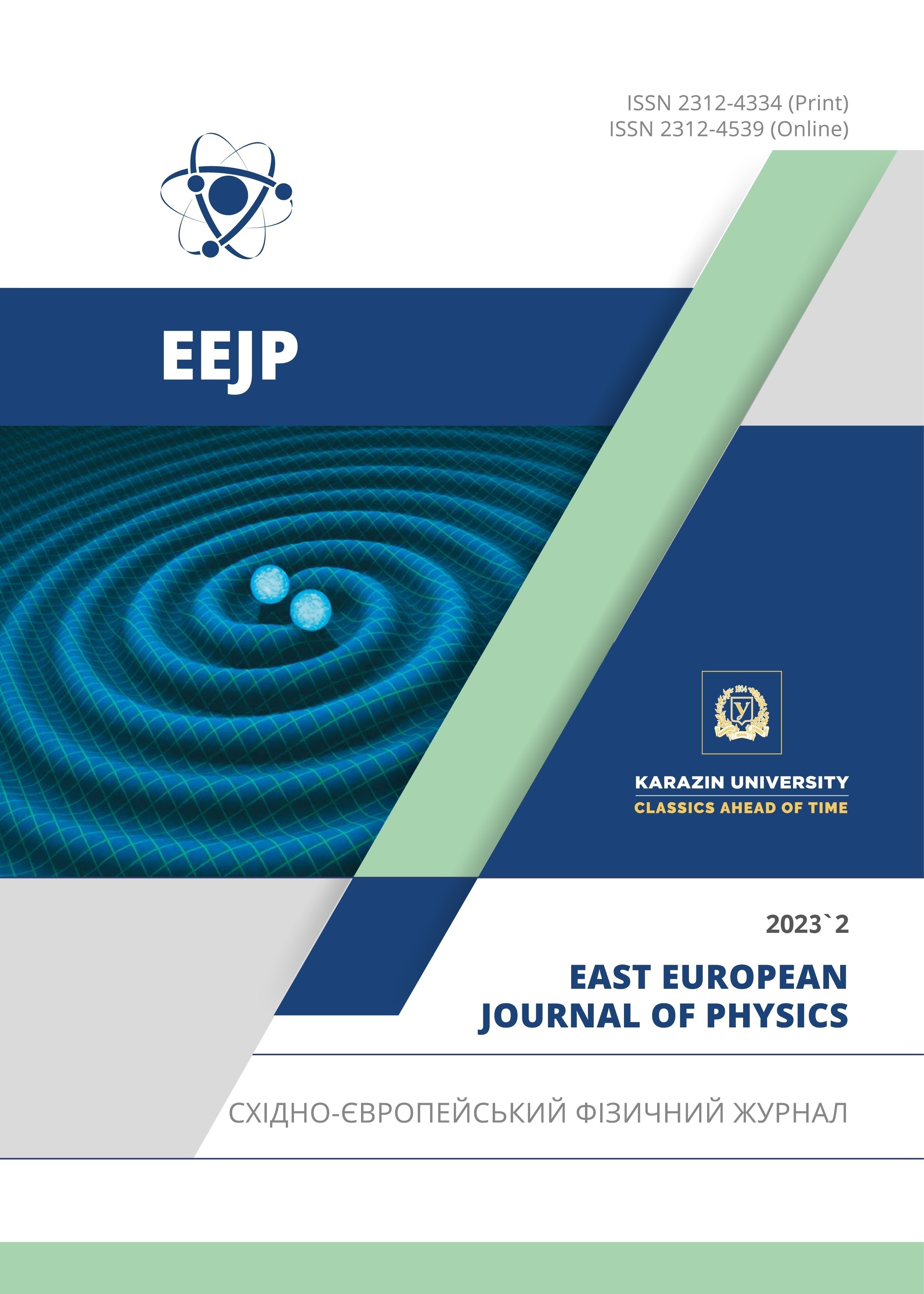Magneto-Thermoelectric Coefficients of Heavily Doped N-Type Mg2Si Material
Abstract
In contrast to parabolic band model typically used in understanding electronic properties in general, thermoelectric and magneto-thermoelectric in particular, this study confirms non-parabolic band model results in better understanding of Seebeck coefficient and Nernst coefficient in the presence of magnetic field for Mg2Si. The magneto Seebeck coefficient was found significantly enhanced from its zero-field value for different electron concentrations in the range 0.6 ‑ 12×1025/m3 and at room temperature due to the magnetic field in the range 0.2 – 1 T for non-parabolic model compared to parabolic band model. The result for Nernst coefficient shows increasing trend as function of magnetic field except for certain electron concentrations for parabolic band model while it is decreasing with magnetic field on average for non-parabolic band model.
Downloads
References
P. Boulet, M.J. Verstraete, J.P. Crocombette, M. Briki, and M.C. Record, “Electronic properties of the Mg2Si thermoelectric material investigated by linear-response density-functional theory,” Computational Materials Science, 50(3), 847-851 (2011). https://doi.org/10.1016/j.commatsci.2010.10.020
N.S. Naser, R.V. Denys, H.F. Andersen, L. Arnberg, and V.A. Yartsy, “Nanostructured Magnesium silicide Mg2Si and its electrochemical performance as anode of a Lithium battery,” Journal of Alloys and Compounds, 718, 478-491 (2017). https://doi.org/10.1016/j.jallcom.2017.05.163
T.H. Nguyen, et al., “On the composition of luminescence spectra from heavily doped p-type Silicon under low and high excitation,” Journal of luminescence, 181, 223-229 (2016). https://doi.org/10.1016/j.jlumin.2016.08.036
M.H. Gebru, “Electrical and thermal conductivity of heavily doped n-type silicon,” Eur. Phys. J. Appl. Phys. 90, 10102 (2020). https://doi.org/10.1051/epjap/2020190332
P.W. Chapman, O.N. Tufte, J.D. Zook, and D. Long, “Electrical properties of heavily doped silicon,” J. App. Phys. 34(11), 3291 3295 (2004). https://doi.org/10.1063/1.1729180
W.G. Spitzer, F.A. Trumbore, and R.L. Logan, “Properties of heavily doped n-type germanium,” Journal of Applied Physics, 32, 1822–1830 (1961). https://doi.org/10.1063/1.1728243
A. Cuevas, P.A. Basore, G.G. Matlakowski, and C. Dubois, “Surface Recombination Velocity of Heavily Doped N-Type Silicon,”Journal of Applied Physics, 80, 3370-3375 (1996). https://doi.org/10.1063/1.363250
H. Zhou, P. Kropelnicki, J.M. Tsai, and C. Lee, “Study of the thermoelectric properties of heavily doped poly-Si in high temperature,”Procedia Engineering, 94, 18-24 (2014). https://doi.org/10.1016/j.proeng.2013.10.011
K. Kikuchi, K. Yamamoto, N. Nomura, and A. Kawasaki, “Synthesis of n-type Mg2Si/CNT Thermoelectric Nanofibers,” Nanoscale Res. Lett. 12, 343 (2017). https://doi.org/10.1186/s11671-017-2120-y
D.W. Rowe, editor, Thermoelectric Handbook: Macro to Nano, (CRC Press/Taylor & Francis, Boca Raton, FL, 2006). https://doi.org/10.1201/9781420038903
H. Wiggers, M.M. Schober, R. Koza, and P. Hermann, “Effects of impurity on the lattice dynamics of nanocrystalline silicon for thermoelectric application,” J. Mater. Sci, 48(7), 2836-2845 (2013). https://doi.org/10.1007/s10853-012-6827-y
C.J. Hwang, “Calculation of Fermi energy and band tail parameters in heavily doped and degenerate n-type GaAs,” J. Appl. Phys. 41, 2268-2674 (1970).http://dx.doi.org/10.1063/1.1659280
P.I. Baranskii, V.M. Babich, and E.F. Venger, “Development of The Physical Insight into The Nature of The Factors That Control Electrophysical and Other Properties of Semiconductors, Semiconductor Physics, Quantum Electronics & Optoelectronics, 4(1), 1-4 (2000). http://journal-spqeo.org.ua/users/pdf/n1_2001/001_4_1.pdf
E.O. Kane, “Thomas-Fermi approach to impurity semiconductor band structure,” Phys. Rev. 133,79-88 (1963). https://doi.org/10.1103/PhysRev.131.79
C. Kittel, Introduction to solid state physics, 7th ed. (John Wiley & Sons Inc., New York, 1996).
J.W. Slotboom, “The pn-product in silicon,” Solid-State Electronics, 20(4), 279-283 (1977). https://doi.org/10.1016/0038-1101(77)90108-3
P. Sengupta, Y. Wen, and J. Shi, “Spin-dependent magneto-thermopower in narrow gap lead chalcogenide quantum wells,” Sci. Rep. 8, 5972 (2018). https://doi.org/10.1038/s41598-018-23511-2
V. Zlatić, and R. Monnier, The Modern Theory of Electricity, (Oxford University press, 2014).
M.H. Gebru, “Thermoelectric coefficients of heavily doped n-type silicon,” East. Eur. J. Phys. 4, 189-196 (2021). https://doi.org/10.26565/2312-4334-2021-4-25
M.H. Gebru, “Electrical and thermal conductivity of heavily doped n-type silicon”, Eur. Phys. J. Appl. Phys. 90, 10102 (2020), https://doi.org/10.1051/epjap/2020190332
S.S. Lee, Semiconducor physical electronics, 2nd ed. (Springer, 2006).
S. Majdi, N. Suntornwipat, M. Gabrysch, and J. Isberg, “Carrier scattering mechanisms: Identifications via the scaling properties of the Boltzmann transport equation,” Advanced Theory and Simulations, 4(1), 2000103 (2021). https://doi.org/10.1002/adts.202000103
T.J. Salez, M. Kouyaté, C. Filomeno, M. Bonetti, M. Roger, G. Demouchy, E. Dubois, et al., “Magnetically enhancing Seebeck in ferrofluids,” Nanoscale Adv. 1, 2979-2989 (2019). https://doi.org/10.1039/C9NA00109C
X. Chen, D. Parker, and D.J. Singh, “Importance of non-parabolic band effects, on the thermoelectric properties of semiconductors,” Sci. Rep. 3, 3168 (2013). https://doi.org/10.1038/srep03168
E.F. Scott, K.A. Schlaak, P. Chakraborty, C. Fu, S.N. Guin, S. Khodabakhsh, A.E.P. y Puente, et al., “Doping as Tuning Mechanism for Magneto-Thermoelectric Effects to Improveɀ T In Polycrystalline NbP,” Phys. Rev. B, 107, 115108 (2023), https://doi.org/10.1103/PhysRevB.107.115108
Copyright (c) 2023 Mulugeta Habte Gebru

This work is licensed under a Creative Commons Attribution 4.0 International License.
Authors who publish with this journal agree to the following terms:
- Authors retain copyright and grant the journal right of first publication with the work simultaneously licensed under a Creative Commons Attribution License that allows others to share the work with an acknowledgment of the work's authorship and initial publication in this journal.
- Authors are able to enter into separate, additional contractual arrangements for the non-exclusive distribution of the journal's published version of the work (e.g., post it to an institutional repository or publish it in a book), with an acknowledgment of its initial publication in this journal.
- Authors are permitted and encouraged to post their work online (e.g., in institutional repositories or on their website) prior to and during the submission process, as it can lead to productive exchanges, as well as earlier and greater citation of published work (See The Effect of Open Access).








